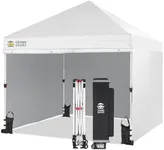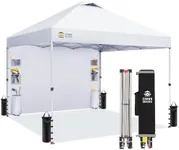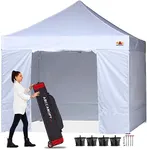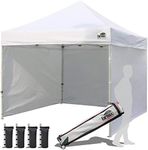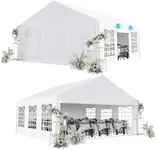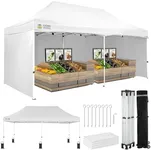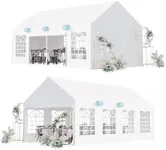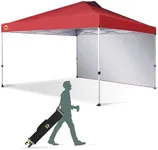Buying Guide for the Best Canopy With Sidewalls
When choosing a canopy with sidewalls, it's important to consider several key specifications to ensure you get the best fit for your needs. Canopies with sidewalls are versatile and can be used for various purposes such as outdoor events, camping, or as a temporary shelter. Understanding the different features and specifications will help you make an informed decision and select a canopy that meets your requirements.SizeThe size of the canopy is crucial as it determines how much space you will have under the shelter. Canopies come in various sizes, typically measured in feet. Smaller canopies (e.g., 10x10 feet) are suitable for intimate gatherings or personal use, while larger canopies (e.g., 20x20 feet or more) are ideal for bigger events or commercial purposes. Consider the number of people you need to accommodate and the space available at your location when choosing the size.
MaterialThe material of the canopy and sidewalls affects durability, weather resistance, and overall performance. Common materials include polyester, polyethylene, and vinyl. Polyester is lightweight and water-resistant, making it suitable for light to moderate use. Polyethylene is more durable and offers better water resistance, ideal for frequent use and harsher weather conditions. Vinyl is the most durable and provides excellent protection against UV rays and heavy rain, perfect for long-term or commercial use. Choose a material based on the expected weather conditions and frequency of use.
FrameThe frame of the canopy provides structural support and stability. Frames are typically made from steel or aluminum. Steel frames are strong and durable but can be heavier and prone to rust if not properly coated. Aluminum frames are lightweight, rust-resistant, and easier to transport, but may not be as strong as steel. Consider the balance between portability and durability when selecting a frame material. For frequent setup and takedown, an aluminum frame might be more convenient, while a steel frame is better for long-term installations.
SidewallsSidewalls offer additional protection from the elements and can provide privacy. They can be solid, mesh, or have windows. Solid sidewalls offer the most protection and privacy, making them suitable for events where you need to shield guests from wind, rain, or prying eyes. Mesh sidewalls allow for better ventilation while still providing some protection from insects. Sidewalls with windows let in natural light and offer a more open feel. Consider the level of protection and privacy you need when choosing the type of sidewalls.
Ease of SetupThe ease of setup is an important factor, especially if you plan to assemble and disassemble the canopy frequently. Some canopies come with a pop-up design that allows for quick and easy setup without the need for tools. Others may require more time and effort to assemble. Look for features such as pre-attached sidewalls, quick-release buttons, and clear instructions to make the setup process smoother. If you often need to set up the canopy by yourself or with minimal help, a pop-up design can save you time and effort.
Weather ResistanceWeather resistance is a key consideration, especially if you plan to use the canopy in various weather conditions. Look for canopies with water-resistant or waterproof materials, UV protection, and wind resistance. Some canopies come with reinforced seams and additional anchoring options to withstand strong winds. Consider the typical weather conditions in your area and choose a canopy that offers adequate protection. For example, if you expect heavy rain, a waterproof canopy with reinforced seams is essential.
PortabilityPortability is important if you need to transport the canopy to different locations. Features such as a lightweight frame, compact design, and carrying case can make it easier to move and store the canopy. Aluminum frames are generally more portable than steel frames due to their lighter weight. Some canopies also come with wheels on the carrying case for added convenience. If you plan to use the canopy at various events or locations, prioritize portability to ensure easy transportation.
